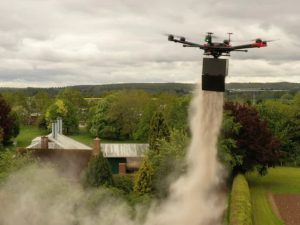Scattering ashes is a deeply personal and symbolic way to honor a loved one, with many choosing nature as the final resting place. Forests, in particular, provide a peaceful setting for ashes scattering. However, questions have arisen about the potential environmental effects of scattering cremated remains in concentrated areas.
The use of drones for scattering ashes offers an innovative solution to this concern, ensuring that the ashes are spread evenly over a wide area, resulting in zero environmental impact. In this article, we’ll explore how drone-based scattering services work and why they are an environmentally conscious option.
Executive summary
Discover how drone scattering of ashes evenly dissipates remains, resulting in zero environmental impact on forests. A sustainable and eco-friendly choice.
What Are Cremated Ashes?
Cremated ashes, also known as cremains, consist primarily of calcium phosphate and trace minerals such as potassium, sodium, and magnesium. These minerals are concentrated after the cremation process, as they are the remains of bone matter. While not toxic, high concentrations of these minerals in one location can potentially disrupt the local environment.
The Environmental Impact of Ashes in Forests
Traditionally, scattering ashes in one concentrated area may lead to alterations in soil composition, potentially impacting plant life. A study published in The Journal of Environmental Quality (2014) noted that large quantities of cremated ashes could increase soil alkalinity, affecting the growth of certain plant species. For instance, trees like oak may not thrive in alkaline soil conditions, whereas species such as pine are more tolerant.
In addition, research from The Ecological Society of America (2018) highlighted that concentrated ashes could disturb the microbial life in soil, which plays a vital role in nutrient cycling and plant growth. This has led to concerns about the environmental impact when ashes are scattered in large quantities in one area.
How Drone Scattering Eliminates Environmental Impact
Drone scattering of ashes addresses these environmental concerns by ensuring that the ashes are dispersed over a large area. When ashes are released by drone, they are scattered at a height that allows for a wide and even distribution. This method effectively dissipates the cremains over a larger space, significantly diluting their concentration in any given spot.
Research from The Forest Ecology and Management Journal (2017) suggests that scattering cremated remains over a broader area reduces the risk of altering the soil’s pH or mineral balance. Drones can scatter ashes across several hundred square meters, ensuring that the concentration of minerals remains low enough to avoid any negative environmental effects.
Key Benefits of Drone Ashes Scattering
- Even Distribution: The primary environmental benefit of drone scattering is that it spreads ashes thinly over a large area, avoiding the buildup of minerals in any one spot. This prevents any potential impact on soil composition, pH levels, or plant growth.
- No Disruption to Microbial Life: By dissipating the ashes over a wider area, the impact on microorganisms in the soil is negligible. These microorganisms are essential for maintaining healthy ecosystems, and drone scattering ensures they remain unaffected.
- Eco-Friendly: Drone-based ashes scattering services are not only respectful of nature, but they also reduce the risk of negatively affecting local flora and fauna. With no need for physical intervention, such as digging or placing urns, this method is an environmentally sustainable choice.
Environmentally Conscious Ashes Scattering Ideas with Drones
If you’re considering using a drone for ashes scattering, it’s important to ensure that the process is respectful to both your loved one and the environment. Here are some ideas:
- Scattering over protected forests: Many services offer drone scattering over protected natural areas, ensuring that the ashes are scattered in a way that minimizes their environmental impact.
- Aerial ceremonies: Drones allow for unique and visually stunning scattering ceremonies, with ashes gently released into the air and dissipating into the wind over a peaceful forest. This approach provides both an emotional and environmental benefit.
- Wide-area scattering: Opting for wide-area scattering ensures that the concentration of minerals from cremated remains is kept low, which is essential for maintaining healthy forest ecosystems.
Why Choose Drone Ashes Scattering?
Drone scattering is not only a modern and symbolic way to say goodbye, but it also ensures that your loved one’s remains are returned to nature in the most eco-friendly way possible. By scattering cremated ashes over a large area, drones help avoid the potential environmental issues associated with traditional ashes scattering practices, ensuring no harm is done to the surrounding forest ecosystem.
In addition, this method allows for a deeply meaningful experience for family and friends, providing a peaceful and beautiful way to honor a loved one while also being mindful of the environment.
Find out more at https://aerialashes-tristate.com/
Follow us on Facebook and Instagram
On YouTube
Or join our Facebook group (Inspiration for Ashes Scattering)


